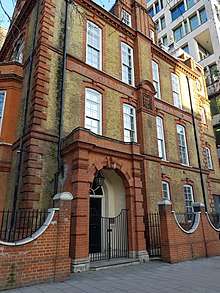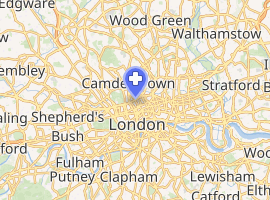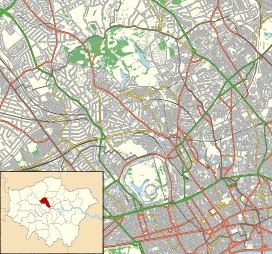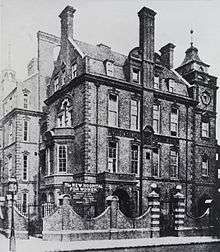Elizabeth Garrett Anderson and Obstetric Hospital
The Elizabeth Garrett Anderson and Obstetric Hospital and its predecessor organisations provided health care to women in central London from the mid-Victorian era. It was named after Elizabeth Garrett Anderson, one of Britain's first female physicians, and its work continues in the modern Elizabeth Garrett Anderson wing of University College Hospital, part of UCLH NHS Foundation Trust.
| Elizabeth Garrett Anderson and Obstetric Hospital | |
|---|---|
 Photograph showing the former New Hospital for Women, Euston Road, London, in 2018. Now occupied by Unison | |

| |
 Location within Camden | |
| Geography | |
| Location | London, NW1 United Kingdom |
| Coordinates | 51.52792°N 0.13065°W |
| Organisation | |
| Care system | NHS England |
| Type | Specialist |
| Services | |
| Emergency department | No |
| Speciality | Obstetrics |
| History | |
| Opened | 1866 |
History


In 1866, Elizabeth Garrett Anderson, with financial backing from her father,[1] founded and became General Medical Attendant to St Mary's Dispensary in Seymour Place, where she worked for over 20 years.[2] This dispensary developed into the New Hospital for Women in 1872.[3][4][5] It was established to enable poor women to obtain medical help from qualified female practitioners - in that era a very unusual thing. In 1874 it moved to Marylebone Road, on a site now occupied by The Landmark Hotel.[1] The foundation stone for new purpose-built facilities in Euston Road was laid by the Princess of Wales in 1889.[1] The architect was J. M. Brydon[6], who took into his employment at this time Anderson's sister Agnes Garrett and her cousin Rhoda Garrett, who contributed to its design.[7] The hospital was renamed the Elizabeth Garrett Anderson Hospital in 1918,[8] in the year following the death of the pioneer physician.[9]
In 1946 the hospital purchased the Hampstead Nursing Home at 40 Belsize Grove (close to Belsize Park Underground station). Between 1948 and 1977 the property in Belsize Grove was known as the Garrett Anderson Maternity Home. The building was subsequently demolished and replaced by residential accommodation.[10]
The Elizabeth Garrett Anderson hospital in Euston Road was under threat of closure from the 1960s and closure was announced in 1976 by Camden Area Health Authority. In November that year the building was occupied by the staff. Campaigning continued until 1979.[11]
In January 2001 the Elizabeth Garrett Anderson Hospital amalgamated with the Obstetric Hospital to form the Elizabeth Garrett Anderson and Obstetric Hospital: it moved to Huntley Street at the same time.[12]
In November 2008, the hospital's maternity and neonatal services moved to the new University College Hospital Elizabeth Garrett Anderson Wing, a £70 million purpose-built wing offering the latest technology and facilities,[12] and the old building in Huntley Street was demolished to make room for the UCH Macmillan Cancer Centre, which opened in April 2012.[13]
Elizabeth Garrett Anderson Gallery
The 1890 core of the former Elizabeth Garrett Anderson Hospital building in Euston Road has been listed and, restored, now forms part of the UNISON Centre. Within this building the Elizabeth Garrett Anderson Gallery is open to the public. The gallery is a permanent installation and uses a variety of media to tell the story of Elizabeth Garrett Anderson, her hospital, and women's struggle to achieve equality in the field of medicine within the wider framework of 19th and 20th century social history. Interactive displays allow the visitor to discover more about the "Enterprising Women" who followed Elizabeth Garrett into the medical profession – and into other spheres of British public life.[14]
See also
References
- "Elizabeth Garrett Anderson Hospital". Lost Hospitals of London. Retrieved 1 July 2018.
- Everett, Jason M.; Thomson Gale. "The People's Chronology". eNotes.com. Archived from the original on 12 October 2007. Retrieved 13 May 2007.
A London dispensary for women opens under the direction of local physician Elizabeth Garrett, now 31, who pioneers the admission of women to the professions, including medicine. The extent of female invalidism, Garrett argues, is much exaggerated by male physicians: women's natural functions are not all that debilitating, she says, pointing out that among the working classes women continue to work during menstruation "without intermission, and, as a rule, without ill effects".
- Elston, Mary Ann. "'Run by Women, (mainly) for Women': Medical Women's Hospitals in Britain, 1866-1948" (PDF). Archived from the original (pdf) on 7 July 2012. Retrieved 28 October 2007.
In July 1866, the St Mary's Dispensary opened in the Marylebone district of London to provide medical advice for working-class women and children. Dispensaries for the thrifty poor were not unusual in Victorian Britain, but St Mary's had a unique feature. The driving force behind it and the main provider of the medical advice was a woman, Dr Elizabeth Garrett.
- "'Run by Women, (mainly) for Women': Medical Women's Hospitals in Britain, 1866-1948". Rodopi. Retrieved 18 September 2008.
- "Elizabeth Garrett Anderson - Victorian Women's Campaigner". BBC. December 2004. Retrieved 28 October 2007.
In 1866 she opened, and was appointed General Medical Attendant to, St Mary's dispensary in Marylebone, where she set about establishing a medical service specifically for women. Not only that, but she started to teach medical courses to other women, so that the practice could expand. The St Mary's dispensary was renamed the New Hospital for Women in the 1870s.
- Goold, David. "Dictionary of Scottish Architects - DSA Architect Biography Report (July 11, 2018, 12:41 pm)". www.scottisharchitects.org.uk. Retrieved 11 July 2018.
- "EGA for Women - The Elizabeth Garret Anderson Gallery". www.egaforwomen.org.uk. Retrieved 11 July 2018.
- "Hospitals". Derelict London.
- M. A. Elston, "Anderson, Elizabeth Garrett (1836–1917)", Oxford Dictionary of National Biography, Oxford University Press, Sept 2004; online edn, Oct 2005.
- "Garrett Anderson Maternity Home". Lost Hospitals of London. Retrieved 1 July 2018.
- "The South London Women's Hospital Occupation 1984-85". Past tense. Retrieved 7 April 2014.
- "UCLH - Our hospitals - University College Hospital Elizabeth Garrett Anderson Wing". Archived from the original on 11 April 2009. Retrieved 5 February 2009.
- "UCH Macmillan Cancer Centre wins RIBA awards". Skanska. 13 June 2013. Retrieved 1 July 2018.
- "The Elizabeth Garret Anderson Gallery". EGA for Women. Retrieved 1 July 2018.
Further reading
- Glynn, Jenifer (15 January 2008). The Pioneering Garretts: Breaking the Barriers for Women. Hambledon Continuum. ISBN 978-1-84725-207-4. Archived from the original on 2 January 2013.
- Crawford, Elizabeth (20 September 2002). Enterprising Women: The Garretts and their Circle. Francis Boutle Publishers. ISBN 1-903427-12-6. Archived from the original on 10 October 2006.
External links
- UCLH - Our hospitals - University College Hospital Elizabeth Garrett Anderson Wing, uclh.nhs.uk; accessed 6 May 2015.
- Lost Hospitals of London: Garrett Anderson Maternity Home, 40 Belsize Grove, Hamsptead, NW3 4TS, ezitis.myzen.co.uk; accessed 6 May 2015.